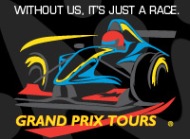Why Seb is so quick
I was looking through the LAT Photographic website the other day for some nice Red Bull action when I came upon these two images, courtesy of Alastair Staley. They were both taken during the race in India at the Turn 8/9 complex – a right-left change of direction of the type that in recent years has become a Seb Vettel signature section. I had to look twice, I have to confess, when I noted Seb’s head position. I rang Alastair to confirm that both photos were indeed taken during the race (ie, that Seb wasn’t on a formation lap) and that they were both travelling at racing speed (ie, that they weren’t behind a Safety Car). As you can see, the two photos captured almost exactly the same piece of road (which was fortunate, because Alastair then moved slightly, rendering further comparisons slightly more difficult). 
 Whilst Mark is still looking at “the corner”, and looks to be carrying a little more load, Seb is already lining up for T9. His car also appears to be “flatter” and carrying slightly less lateral load. As we chatted, Alastair allowed that he had often noticed Seb’s very different mid-corner head position but that it was difficult to capture this. We’re talking a millisecond here, a moment in time. I dare say that other great drivers have in the past “been able to get their corners over sooner”; it’s only now that we are in the digital age that the law of averages is coming into play. I don’t profess to have all the answers – and nor does Rob Wilson, who openly admits that he is learning something new (about the business of driving) every day. I could think of no-one better than Rob, though, to analyse these two photos. As well as winning all over the world in a variety of motor racing disciplines, Rob has coached, or coaches, many of today’s stars, including Giedo van der Garde, with whom we talk in Part 3 of this week’s show, Valtteri Bottas, Sergio Perez, Pastor Maldonado, Kevin Magnussen and – right back in his Formula Renault days – Kimi Raikkonen.
Whilst Mark is still looking at “the corner”, and looks to be carrying a little more load, Seb is already lining up for T9. His car also appears to be “flatter” and carrying slightly less lateral load. As we chatted, Alastair allowed that he had often noticed Seb’s very different mid-corner head position but that it was difficult to capture this. We’re talking a millisecond here, a moment in time. I dare say that other great drivers have in the past “been able to get their corners over sooner”; it’s only now that we are in the digital age that the law of averages is coming into play. I don’t profess to have all the answers – and nor does Rob Wilson, who openly admits that he is learning something new (about the business of driving) every day. I could think of no-one better than Rob, though, to analyse these two photos. As well as winning all over the world in a variety of motor racing disciplines, Rob has coached, or coaches, many of today’s stars, including Giedo van der Garde, with whom we talk in Part 3 of this week’s show, Valtteri Bottas, Sergio Perez, Pastor Maldonado, Kevin Magnussen and – right back in his Formula Renault days – Kimi Raikkonen.
I think you will enjoy his detailed observations (below) in Part 1 of The Racer’s Edge, Episode 36.













And actually it looks like Vettel is a little bit behind Webber’s position. You can see a lot more kerb in Webber photo. So Vettels is looking at the next turn without even being yet in the same position as Webber in the previous one.
Guess it’s just one of those seasons when everything is perfect, everybody’s laughing, everybody’s happy, here comes the sun king, sort of Ferrari 2004, but then there’s always 2005 Ferrari season, helter skelter. Could happen to Seb and RBR.
Great champs are known for this type of metronomic driver quality as Seb. It’s curious Mark’s been talking about motivation, I’m anxious to see how a demotivated Vettel is going to operate in the future, because at one point you’ve got, then you lose it and it’s gone, forever, just like that.
Can’t blame Vettel for grabbing the opportunity with 4 titles, it’s also true that others are not doing a fantastic job. Failure shouldn’t be an option. Maybe if they balanced team budgets a little bit, RBR are so obviously outspending everyone, apparently or let’s say it seems to be the case from the outside looking in.
Here’s what I think… Webber drives with his mind in the car while Vettel drives with his mind 6 feet in front of the car…
Thanks. Yes, as Rob says, what’s ahead should already be behind…
One significant thing that distinguishes TRE from other periodicals that cover F1 and motorsport is TRE’s focus on, and appreciation of, the beauty and techniques of a racer maximizing their car.
Listening to Rob on TRE is very educational, and I’m always grateful when he agrees to appear. The level of driving talent in F1 is very high, but thanks to TRE and Rob, I have a greater understanding on the subtle variations of styles and techniques of drivers.
Thank you for publishing the large versions of these two photos. From my own experience of amateur motorsports, I’ve noticed that a good photography gallery can be a very good tool to observe the dynamics of drivers and vehicles on a track, often more so than video. These two photos are a good example of that.
According to the exif info embedded in the images, the picture of Webber was taken 12 seconds prior to the picture of Vettel.
Very good work here… thanks again!
Thanks. I hadn’t spotted the exact timing, so I’m glad you pointed that out. As I say, I don’t think Seb is the only driver – past or present – with this sort of ability. It’s nice, though, that a still photographer has been able to capture it in this form. I just wish that photographers back in the 1950s and 1960s had been able to stand there with digital cameras, shooting hundreds of shots of Moss, Fangio and Clark! Back then, your staff photographer would probably have taken eight/ten rolls of black and white and perhaps five rolls of Kodachrome over the three/four days of an F1 weekend. Full credit to Alastair Staley and LAT Photographic.
Fascinating visual example of “looking where you want to go” not at “where you are.” I have trained over 20,000 individuals on skid pads/pans right across Canada and my primary message was to “look up and look where you want to go.” In every case the driver would respond/react with the appropriate amount brake pedal pressure and steering lock and were able to avoid an imminent collision. I’m talking all ages and stages of drivers. Translating this to the racetrack was very easy. Look up, look past the corner apex to the exit and then further down the track to the next corner entrance. Much of what I learned came from Canada’s Sports Vision Training Institute visual tracking research. The successes of the “Crazy Canucks,” a group of Canadian alpine ski racerswho rose to prominence in the World Cup during the 1970s and ’80s, was due to their visual tracking skills taught by the Institute. I fall back on “where you stare is where you steer” when concluding a driving seminar. Thanks for posting the photos: a perfect example of this visual phenomenon.
Gary Magwood
Gary Magwood Latta Mills, Ontario 613 477 1264
�I start from the premise that no object created by man is as satisfying to his body and soul as a proper sailing yacht.� Arthur Beiser (The Proper Yacht)
Gary – thanks for that. As it happened, I met Steve Podborski and Ken Read several times because they were great F1 fans. Brilliant guys both. I always have thought that downhill skiing is the closest of all sports to F1 – closer than bikes or rallying.